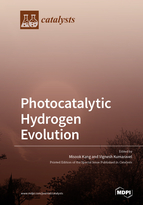Photocatalytic Hydrogen Evolution
A special issue of Catalysts (ISSN 2073-4344). This special issue belongs to the section "Photocatalysis".
Deadline for manuscript submissions: closed (30 April 2019) | Viewed by 57417
Special Issue Editors
Interests: nanomaterials; energy; environmental; catalysis; chemistry
Special Issues, Collections and Topics in MDPI journals
Interests: photocatalysis; electrocatalysis; antimicrobial polymers; CO2 conversion; self-cleaning coatings
Special Issues, Collections and Topics in MDPI journals
Special Issue Information
Dear Colleagues,
Energy crises and global warming are key challenges for researchers in order to develop a sustainable society for the future. Solar energy conversion is a remarkable, clean, and sustainable solution to nullify the effects of fossil fuels. The findings of photocatalytic hydrogen production (PCHP) by Fujishima and Honda realized that “water will be the coal for the future”. Hydrogen is a carbon-free clean fuel with a high specific energy of combustion. Titanium oxide (TiO2), graphitic-carbon nitride (g-C3N4) and cadmium sulfide (CdS) are three pillars of water splitting photocatalysts owing to their superior electronic and optical properties. Tremendous research efforts have been made in recent years to fabricate visible or solar-light, active photocatalysts. The main aim of this Special Issue is to present the significant features of oxide, sulfide, and carbon based photocatalysts for cost-effective hydrogen production.
We are pleased to invite submissions in the form of original research articles, communications, and short reviews that reflect key findings of semiconductor photocatalysts in the following topics: UV or visible or solar light assisted hydrogen production; photocatalytic hydrogen evolution (PCHE) using seawater/industrial waste water; and photocatalytic reactor design for efficient hydrogen production.
This Special Issue is not limited to the above-mentioned topics, but also welcome manuscripts on novel photocatalytic materials, systems, or mechanisms for hydrogen production.
Prof. Dr. Misook Kang
Dr. Vignesh Kumaravel
Guest Editors
Manuscript Submission Information
Manuscripts should be submitted online at www.mdpi.com by registering and logging in to this website. Once you are registered, click here to go to the submission form. Manuscripts can be submitted until the deadline. All submissions that pass pre-check are peer-reviewed. Accepted papers will be published continuously in the journal (as soon as accepted) and will be listed together on the special issue website. Research articles, review articles as well as short communications are invited. For planned papers, a title and short abstract (about 100 words) can be sent to the Editorial Office for announcement on this website.
Submitted manuscripts should not have been published previously, nor be under consideration for publication elsewhere (except conference proceedings papers). All manuscripts are thoroughly refereed through a single-blind peer-review process. A guide for authors and other relevant information for submission of manuscripts is available on the Instructions for Authors page. Catalysts is an international peer-reviewed open access monthly journal published by MDPI.
Please visit the Instructions for Authors page before submitting a manuscript. The Article Processing Charge (APC) for publication in this open access journal is 2700 CHF (Swiss Francs). Submitted papers should be well formatted and use good English. Authors may use MDPI's English editing service prior to publication or during author revisions.
Keywords
- PCHE under UV or visible or simulated solar light
- PCHE from seawater/ industrial waste water
- PCHE without electron-donors
- PCHE with in-situ electron donors
- Mechanistic aspects of PCHE







